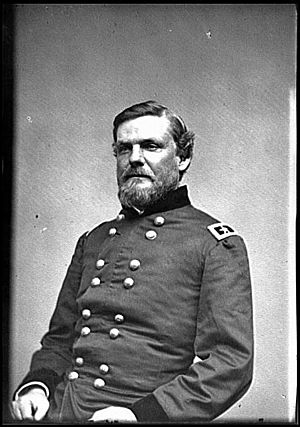John Newton (engineer) facts for kids
Quick facts for kids
John Newton
|
|
|---|---|

John Newton
|
|
| Born | August 24, 1822 Norfolk, Virginia |
| Died | May 1, 1895 (aged 72) New York City, New York |
| Place of burial |
West Point National Cemetery
|
| Allegiance | United States of America Union |
| Service/ |
United States Army Union Army |
| Years of service | 1842–1886 |
| Rank | |
| Commands held |
|
| Battles/wars | |
| Other work |
|
John Newton (born August 24, 1823 – died May 1, 1895) was an important engineer and a brave general during the American Civil War. He was a career officer in the United States Army and later became the Chief of the United States Army Corps of Engineers.
Contents
Early Life and Education
John Newton was born in Norfolk, Virginia. His father, Thomas Newton, Jr., was a politician who served in the U.S. Congress for 31 years.
John was a very smart student. He graduated from the United States Military Academy in 1842. He was the second-best student in his class! After graduating, he joined the Corps of Engineers.
From 1843 to 1846, he taught engineering at West Point. Then, he worked on building strong defenses along the Atlantic coast and the Great Lakes until 1852. He also helped plan defenses for the Gulf Coast in 1856. In 1858, he was the Chief Engineer for the Utah Expedition.
Serving in the Civil War
Even though John Newton was from Virginia, a state that joined the Confederacy, he chose to stay loyal to the Union. He played a key role in building defenses around Washington, D.C.
Early Battles and Leadership
Newton led a group of soldiers, called a brigade, in the Peninsula Campaign. During the Maryland Campaign, he showed great courage at the Battle of South Mountain. He led a bayonet charge, where soldiers attack with bayonets fixed to their rifles, and successfully captured the enemy's position. He also fought bravely at the Battle of Antietam.
Later, as a division commander in the VI Corps, he took part in the Battle of Fredericksburg. This battle was a tough loss for the Union. After the defeat, Newton and other generals met with President Abraham Lincoln. They told him they had lost faith in their commander, Ambrose Burnside. This meeting was one reason Burnside was replaced in January 1863.
Newton was promoted to major general on March 30, 1863. However, Congress never officially approved this promotion, so it ended a year later.
Chancellorsville and Gettysburg
In the Chancellorsville Campaign, Newton was injured at the Battle of Salem Church.
At the famous Battle of Gettysburg, Newton was given an important command. The commander of the I Corps, John F. Reynolds, was killed early in the battle. George Meade, the Union Army commander, chose Newton to lead the I Corps. He preferred Newton over Abner Doubleday, who was next in line, because he trusted Newton's fighting skills more.
Newton commanded the I Corps until the spring of 1864. At that time, the I Corps was broken up, and its soldiers joined other corps. Newton then went back to his rank of brigadier general and was sent to serve with General William T. Sherman in the West.
Campaigns in the West
During the Atlanta Campaign, Newton commanded the 2nd Division of the IV Corps. He served under General George H. Thomas and was highly respected by General Sherman.
At the Battle of Peachtree Creek, Newton stopped a dangerous attack by the Confederate forces. His quick actions and strong defenses helped turn back the Confederates. This victory helped his military career get back on track.
After Atlanta was captured, Newton left active field duty. From 1864 to 1866, he commanded the District of Key West and the Tortugas in Florida. His last battle was a defeat at the Battle of Natural Bridge in Florida in March 1865. This allowed the Confederates to hold onto the state capital for a little longer.
Life After the War
After the Civil War, John Newton returned to the Corps of Engineers. He was in charge of improving waterways around New York City, in Vermont, and along the Hudson River above Albany. He also managed New York Harbor defenses.
Hell Gate Project
Newton became famous for a huge engineering project in New York City. He was responsible for clearing the dangerous "Hell Gate" rocks, which made shipping difficult.
On October 10, 1885, he used a massive amount of explosives to destroy these rocks. He blew up the three-acre Hallet's Point Reef with 50,000 pounds of nitroglycerine. Then, he destroyed the nine-acre Flood Rock with 282,730 pounds of dynamite! This explosion removed over 730 million pounds of rock, making the waterways much safer.
For his amazing achievements, he was chosen to be a member of the National Academy of Sciences.
Later Career and Legacy
Newton retired from the Army in 1886. After that, he served as the Commissioner of Public Works for New York City from 1886 to 1888. He then became the President of the Panama Railroad Company from 1888 to 1895.
John Newton passed away in New York City on May 1, 1895, due to heart disease and rheumatism. He is buried at West Point.
In 1886, he received the Laetare Medal from the University of Notre Dame. This is a very old and respected award for American Catholics.
In 1899, the Corps of Engineers named a 175-foot paddlewheeler boat after Newton to honor him. This boat was later used as the Minnesota Centennial Showboat until it was destroyed by fire in 2000.

